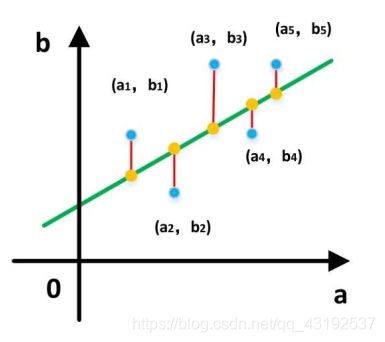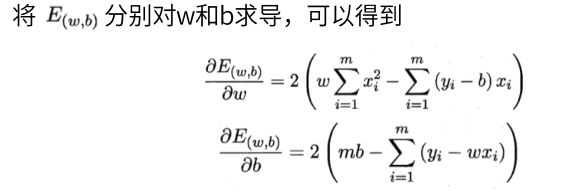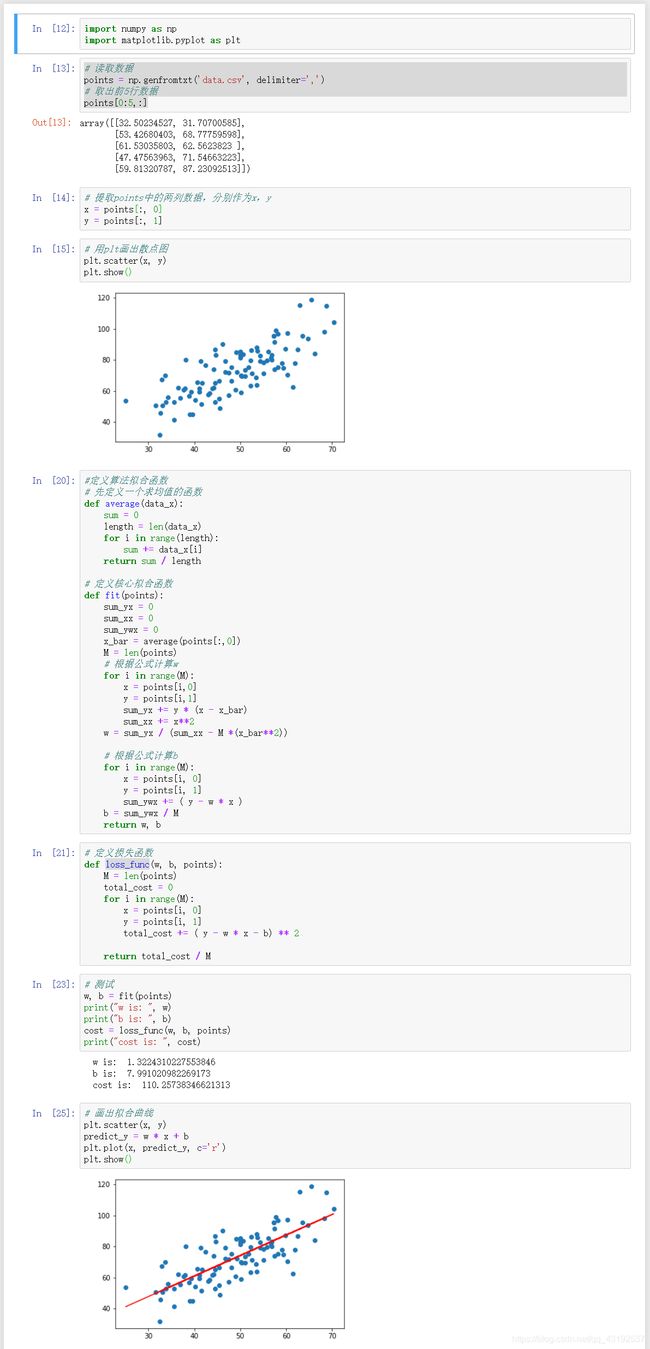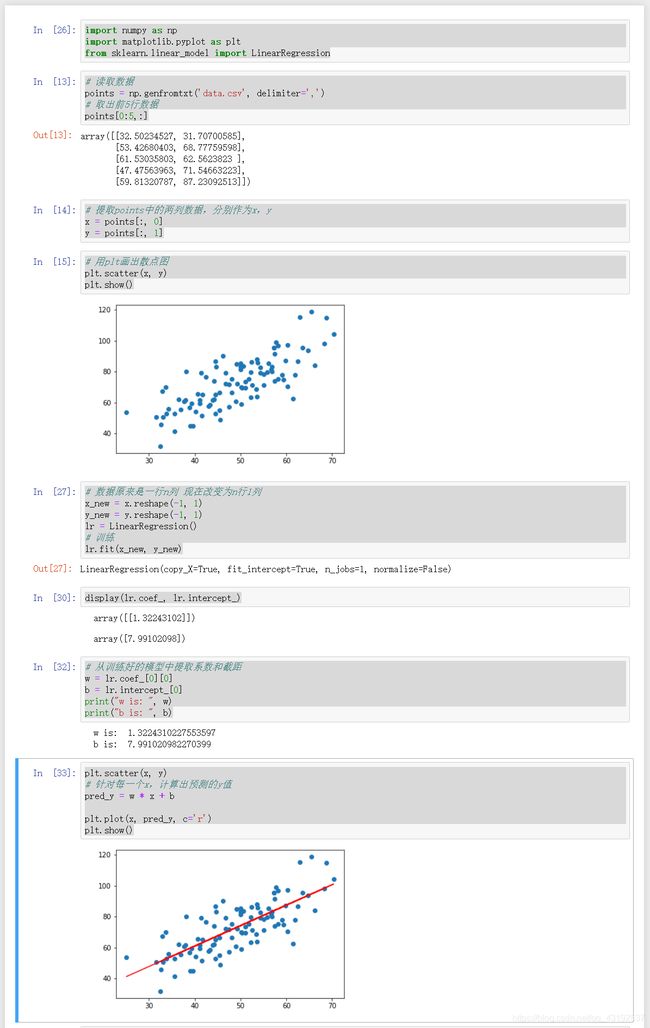线性回归
目录
- 一元线性回归
- 最小二乘法求解思想
- 用代码求解w b
- jupyter notebook
- 源码
- sklearn库实现求w b
- jupyter notebook
- 源码
- 梯度下降求解线性回归
-
一元线性回归
通常当数据只有一个特征时,可表示函数为 f(x) = wx + b,但是实际的数据可能有多个特征,那么这时就可以表示为多元函数了,但是我们现在只考虑一元函数的求解
这里的f(x) 和 x都是已知的,且有多组,未知的是w,b,这正是我们要求解的,以下我们用最小二乘法求解
-
最小二乘法求解思想
各个点到直线的欧式距离的平方和的最小时,求此时函数的偏导数,并将偏导数等0所计算出来的w和b,就是我们要求解的
-
用代码求解w b
数据下载
-
jupyter notebook
-
源码
import numpy as np
import matplotlib.pyplot as plt
# 读取数据
points = np.genfromtxt('data.csv', delimiter=',')
# 取出前5行数据
points[0:5,:]
# 提取points中的两列数据,分别作为x,y
x = points[:, 0]
y = points[:, 1]
# 用plt画出散点图
plt.scatter(x, y)
plt.show()
#定义算法拟合函数
# 先定义一个求均值的函数
def average(data_x):
sum = 0
length = len(data_x)
for i in range(length):
sum += data_x[i]
return sum / length
# 定义核心拟合函数
def fit(points):
sum_yx = 0
sum_xx = 0
sum_ywx = 0
x_bar = average(points[:,0])
M = len(points)
# 根据公式计算w
for i in range(M):
x = points[i,0]
y = points[i,1]
sum_yx += y * (x - x_bar)
sum_xx += x**2
w = sum_yx / (sum_xx - M *(x_bar**2))
# 根据公式计算b
for i in range(M):
x = points[i, 0]
y = points[i, 1]
sum_ywx += ( y - w * x )
b = sum_ywx / M
return w, b
# 定义损失函数
def loss_func(w, b, points):
M = len(points)
total_cost = 0
for i in range(M):
x = points[i, 0]
y = points[i, 1]
total_cost += ( y - w * x - b) ** 2
return total_cost / M
# 测试
w, b = fit(points)
print("w is: ", w)
print("b is: ", b)
cost = loss_func(w, b, points)
print("cost is: ", cost)
# 画出拟合曲线
plt.scatter(x, y)
predict_y = w * x + b
plt.plot(x, predict_y, c='r')
plt.show()
-
sklearn库实现求w b
-
jupyter notebook
-
源码
import numpy as np
import matplotlib.pyplot as plt
from sklearn.linear_model import LinearRegression
# 读取数据
points = np.genfromtxt('data.csv', delimiter=',')
# 取出前5行数据
points[0:5,:]
# 提取points中的两列数据,分别作为x,y
x = points[:, 0]
y = points[:, 1]
# 用plt画出散点图
plt.scatter(x, y)
plt.show()
# 数据原来是一行n列 现在改变为n行1列
x_new = x.reshape(-1, 1)
y_new = y.reshape(-1, 1)
lr = LinearRegression()
# 训练
lr.fit(x_new, y_new)
display(lr.coef_, lr.intercept_)
# 从训练好的模型中提取系数和截距
w = lr.coef_[0][0]
b = lr.intercept_[0]
print("w is: ", w)
print("b is: ", b)
plt.scatter(x, y)
# 针对每一个x,计算出预测的y值
pred_y = w * x + b
plt.plot(x, pred_y, c='r')
plt.show()
-
梯度下降求解线性回归
梯度就是函数的变化率,变化率也就是函数的导数,当函数的变化率不在改变时,也就意味着导数为0
import numpy as np
points = np.genfromtxt('../data/data.csv',delimiter=',')
points[0:5,:]
X = points[:,0]
y = points[:,1]
class Linear_model(object):
def __init__(self):
self.w = np.random.randn(1)[0]
self.b = np.random.randn(1)[0]
# 模型函数
def model(self, x):
return self.w * x + self.b
,
def loss(self,x, y):
# 求w和b求偏导
g_w = 2 * (y - self.model(x))*(-x)
g_b = 2 * (y - self.model(x))*(-1)
return g_w, g_b
def gradient_descend(self,g_w, g_b, step = 0.01):
self.w = self.w - g_w * step
self.b = self.b - g_b * step
def fit(self,X, y):
w_last = self.w + 1
b_last = self.b + 1
precision = 0.00001
max_count = 200
count = 0
while True:
if(np.abs(self.w - w_last) < precision) and (np.abs(self.b - b_last) < (precision)):
break
if count > max_count:
break
size = X.shape[0]
g_w = 0
g_b = 0
# 将所有点代入到此时的w和b对应的偏导数中,累加后,求出所有点的偏导数的平均值
for xi, yi in zip(X, y):
g_w += self.loss(xi, yi)[0] / size
g_b += self.loss(xi, yi)[1] / size
self.gradient_descend(g_w, g_b)
count += 1
def coef_(self):
return self.w
def intercept_(self):
return self.b
lm = Linear_model()
# X数据必须是二维的 y可以是二维的,也可以是一维的
# 如果y是二维的,coef_也是二维的
# 如果y是一维的,coef_也是一维的
lm.fit(X.reshape(-1, 1),y)
display(lm.coef_(),lm.intercept_())






